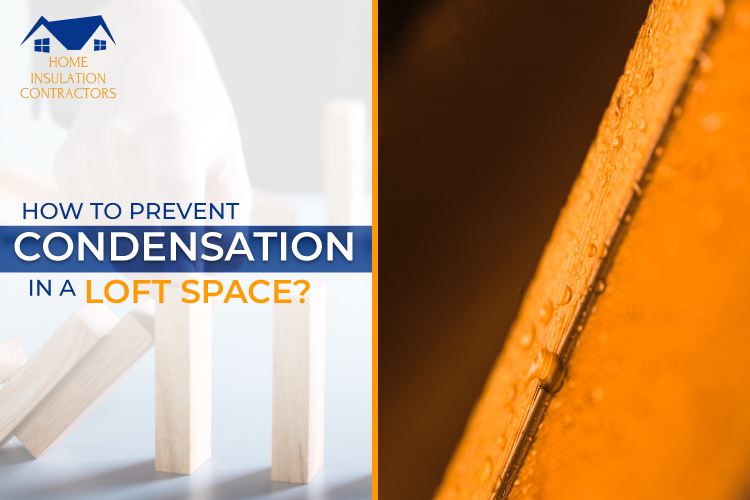Condensation and spillages can accumulate in any season of the year. Patches of dampness, wetness on the inside of windows, or unattractive black patches on the walls are some of the earliest warnings of condensation in a loft space in many parts of the UK. In more severe cases, you can also notice that the linens or other objects you keep in your loft are growing mould spores.
Throughout the winter, condensation around the house is a persistent problem, causing windows to get damp and foggy. We are all familiar with the attempted methods for preventing condensation, such as cross ventilation and keeping our houses toasty but not overly damp during the winter. Insulation is a terrific method to increase the energy efficiency of your home and prevent the frequent occurrence of condensation.
It is critical to address any of these problems as soon as you become aware of them. When left uncontrolled, excess moisture can start to decay away the wooden battens in your roof, which poses serious health dangers such as coughing, constant illness, Breathing problems and unexpected dampness and mould formation.
Fortunately, condensation in the loft space can be prevented if the appropriate actions like insulating the loft space with spray foam insulation are carried out in a timely and proper manner.
With Home Insulation Contractors, you can contact local and national insulation firms with just one click, and receive FREE, no-obligation estimates from reputable and accredited installers with a free loft condensation survey thereby sparing you money and time.
Why ventilation is important?
Consider the original use of the loft space to understand why ventilation is crucial to preventing condensation in loft conversion. Of course, lofts were designed to have good ventilation. They were constructed in this fashion to make it easy for any condensation or dampness to escape.
Condensation may become a significant concern with loft conversions since adding a new space in the loft eliminates the cold roof. If the lost ventilation is not replaced, dampness will seep into the roof timbers and cause decay. A ventilation passage must be established to guarantee that damp air is permitted to leave.
The air can flow and then exit from the roof using this ventilation channel. As a result, the air’s moisture doesn’t have a chance to condense and damage the timbers. Naturally, the original draught issue reappears once this ventilation passage is established. By adding loft foam insulation between rafters, this can be resolved.
Why Does Condensation Occur in the Loft?
It happens in your loft area when too much moisture in the air cannot leave because of insufficient ventilation, just like even benign condensation. There are numerous explanations as to why this can be occurring in your home.
- Inconvenient Loft Insulation
The installation of modern ineffective loft insulation frequently results in condensation. Effective Loft insulation with spray foam offers a number of advantages, including improved energy efficiency, lower utility costs, and more pleasant living space. These benefits are well known and can potentially increase the value of your home while reducing yearly energy bills. Effective loft insulation will permit your home’s capacity to ventilate and “breathe.” Therefore, the loft area in the home will be breezier and more pleasant to live in.
- A loft With Water Tanks
The hot water tanks in many British homes are located in the loft. While they typically don’t cause problems, it’s still important to make sure yours is in working order. If the lid has come off, the steam that is released will eventually condense and cause more frequent issues. Your hot water tanks should be inspected yearly or properly insulated, especially right before the winter weather when condensation can be an increasingly larger concern.
- Poorly Insulated Loft Hatches
Warm, moist air from underneath will be able to enter the loft space if your loft hatch is improperly installed or is insufficiently insulated. Condensation is more likely to build in your loft area if there are ventilation problems. This air will condense and form pools if it builds up, rises, and strikes the chilly innermost layer of your roof, such as the membrane or the slates. The result of this extra moisture is dampness, mould, and rot.
- Laundry
If at all possible, stay away from drying clothes inside on clothes maidens. If necessary, ensure the space is well-aired by leaving the windows open. According to investigations, drying garments indoors can result in a 30% increase in interior moisture levels causing dampness.
Ways to prevent condensation in your loft
- It’s critical to control the temperature in your loft to prevent heat accumulation that dissolves snow and causes humidity. This comprises either ensuring suitable ventilation or setting up airtight insulation. While foam insulation is ideal for attics that require an airtight barrier and a constant temperature, soffit vents are helpful for ensuring that fresh, cold air is always circulated throughout your attic.
- It is important to make sure your downspouts and downpipes are leak-proof and secure since defective downspouts and downpipes can cause the exterior walls of your home to get wet and chilly. This could result in penetrating moisture that compromises structural integrity if left unchecked.
- A constant airflow should pass through your house through the chimneys, vents, brickwork, etc. By doing this, condensation accumulation will be reduced. To prevent dirt and dust from obstructing them and enabling moisture to build up, ensure that you clean these frequently.
Conclusion
Condensation in loft spaces is frequently caused by an imbalance between your home’s insulation and ventilation levels. Many older homes have little to no loft ventilation because they are so inadequately insulated. In order to deal with the rise in warm air within the house, it is crucial to improve ventilation as we increase insulation in our homes. Lastly, if you want to stop condensation in your loft space, ensure adequate loft insulation with spray foam which is the ideal and most effective solution.


